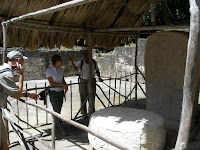
First coffee: Guatemala, El Salvador, Nicaragua, and Costa Rica, have all claimed to grow some of the best coffee! Costa Rica has gone as far as to say they have the best coffee! We heard claims such as ‘we have great altitude for growing coffee’, ‘our growing season is long allowing the coffee to become more mature’, and ‘our plants [growing next to the coffee plants] provide good shade for the coffee.’ In addition to hearing these claims, we’ve gotten some personal exposure to the cherished ‘red cherries’ or coffee beans.

In El Salvador we got up-close-and-personal with coffee plants for the first time, walking a local woman’s coffee finca (farm). In Nicaragua, a gringo showed us how he and his brothers grow, cultivate, and roast their own coffee (with the help of their local Nicaraguan labor force, of course). While there, Joe enjoyed a cup or two or three of the home-grown product. Finally, in Costa Rica, thanks both to our generous host and the country’s coffee tourism infrastructure, we visited an industrial-sized coffee finca. This large-scale operation, Espiritu Santo it was called, purportedly sends its roasted beans to the likes of Starbucks, among others. Coffee, in short, is omnipresent. And we’re not even to coffee powerhouse Colombia!
Coffee picking season is approximately 2 ½ months long and is occurring right now!
 Hence, on our visit to Espiritu Santo a few days ago the migrant worker coffee pickers (we were told 95% are Nicaraguans), many accompanied by their families, were not in short supply. Talk about getting (somewhat uncomfortably) up-close-and-personal! We’ll save further discussion on the labor behind the beloved fruits for a different time (or blog).
Hence, on our visit to Espiritu Santo a few days ago the migrant worker coffee pickers (we were told 95% are Nicaraguans), many accompanied by their families, were not in short supply. Talk about getting (somewhat uncomfortably) up-close-and-personal! We’ll save further discussion on the labor behind the beloved fruits for a different time (or blog).As for bananas, did you know that there are several varieties of bananas? The banana world is much larger than “Vietnamese Cavendish banana” you find at your local store. Varieties are sweet, bitter, large, small, fat, and skinny. It is always an event to pick a new variety at the market and compare them to previously eaten varieties. We both swear by one variety eaten we at on “our” Nicaraguan island farm. The problem… we have no idea what kind it was! We both recall this perfect banana being medium in length, really fat, and incredibly sweet and perfect for milk-banana-cinnamon licuados!!

While the banana fincas don’t seem to have the same tourist allure as coffee fincas, we both read a book about the United Fruit company now Chiquita Bananas. The pervasive and destructive octopus company, as it was known to local Latin Americans, seemed to control Central America. Railroads, schools, and health clinics were all constructed under the octopus’s control. The banana republics took several years of organizing and fighting to regain their “independence” .
As our journey continues, we are going to keep exploring banana varieties, searching for the ultimate banana. Joe is going to keep refining his coffee pallet. And, we are going to keep looking to how these delectable goodies are made! Today we saw our first industrial pineapple finca, owned by none other than everyone’s favorite Del Monte.







































